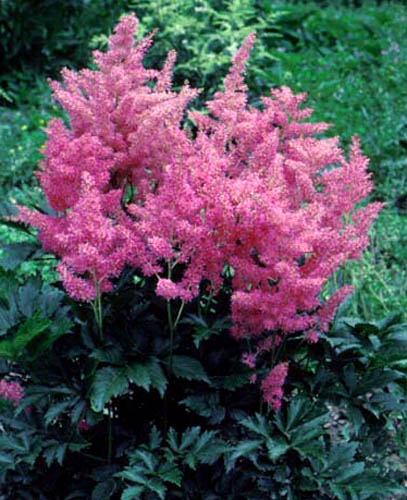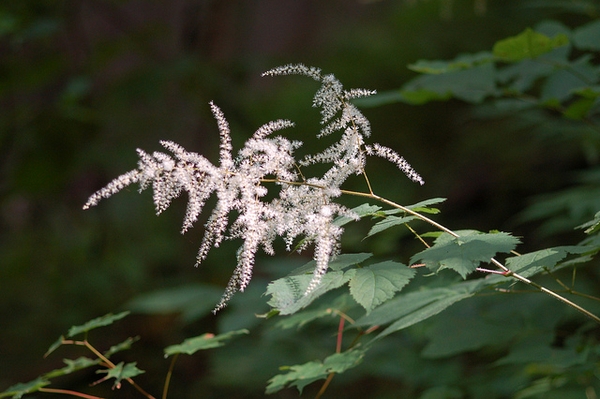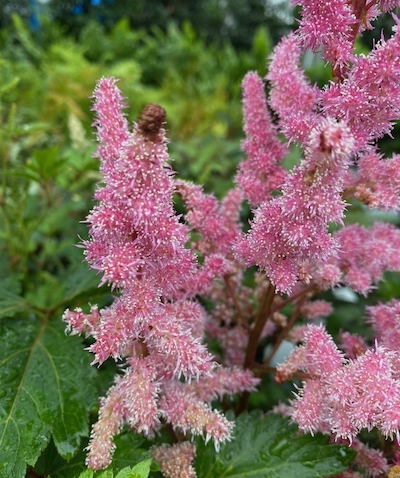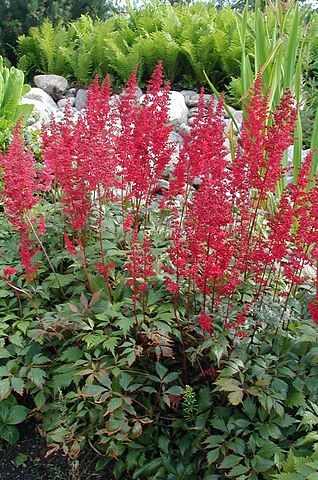Astilbe, A Beautiful and Unique Multi-Season Perennial
by Carolyn R. Casey, Fairfax Master Gardener

Hybrid astilbe x arendsii
Astilbe is a low maintenance perennial that attracts pollinators, making a wonderful addition to your garden for all to enjoy. The genus name, Astilbe, is derived from the Greek words meaning “without brightness.” These are said to reference some of the species having dull leaves. It has beautiful and unique solid colored feathery, lacy and silky plume-like blooms in the mid spring to late summer. It is native to Asia and North America and grows in Zones 3 to 8.
Astilbe blooms in shades of white, pink, purple and red on tall stems that grow 6 to 24 inches (15 to 60 cm) tall and 6 to 60 (15 to 150 cm) inches wide. The blooms will last for quite a few weeks and do not need to be deadheaded. The foliage has ternately (arranged in threes) or biternately compound leaves that are ovate and doubly serrated. They range in color from red, bronze or green.
Astilbe grows best in part shade but also grows in partial to full sun or full shade. It blooms in full shade but needs a little sunlight to reach full size. It is best to plant astilbe in the spring or fall. It needs to be planted in the shade or watered often when planted in hot and dry climates. Most modern hybrids are not especially heat or drought tolerant and will wilt or suffer dieback due to midsummer dormancy without supplemental irrigation. If planted in full sun in these climates, the foliage will burn.
When it has not rained, water astilbe weekly and deeply at the base, keeping the soil moist but not soggy. Do not water it overhead since this may cause mildew. Astilbe likes rich, loamy moist, acid soil with a pH of 6.0 to neutral.
Fertilize astilbe with 5-10-5 or 10-10-10 since it needs phosphorus to bloom. Rake the fertilizer into the soil two weeks before planting your astilbe or sprinkle a little of the fertilizer onto the soil after planting. Every spring, fertilize it if needed when the soil is moist. Avoid getting fertilizer on the foliage.

Astilbe biternata
To keep astilbe healthy, divide it every four to five years. It is a slow growing plant that has established blooms for many years before needing to be divided. To divide astilbe, dig up the root ball in the early spring and separate it into identical sized pieces with a shovel. Plant the astilbe pieces back at the same soil level and water after planting. Keep the divisions watered after replanting, and they will establish quickly.
It will survive the winter but after the first hard frost, put 2 inches (5 cm) of mulch around the stem to protect the roots. Astilbe is a nearly trouble-free plant with very few diseases or insect problems. Groundhogs or rabbits may nibble on the tender new growth; however, it does not suffer long term damage once it is mature.
Astilbe biternata is a tall herbaceous perennial with white feathery flowers and foliage that looks like a fern. It is in the Saxifragaceae family and is known as Appalachian false goat’s beard and false goat’s beard. False goat’s beard is the only astilbe that is native to North America. It grows 3 to 6 feet (1 to 2 m) tall and 2 to 3 (.75 to 1 m) feet wide. It is a deciduous plant that is low maintenance and has a medium growth rate. It likes dappled sunlight, partial shade or two to six hours of direct sunlight. It likes acidic soil with a pH of 6.0 or neutral 6.0 to 8.0. It prefers soil that is well drained and is high in organic, loam or silty soil. It grows in Zones 5 to 8 with a medium growth rate. It has creamy tan, pink or white clusters of flowers that bloom in the spring and summer. The flowers have 10 stamens with four to five narrow petals. It has both male and female plants. The foliage is green with pinnately compound leaves that separate into two parts and then divide again into three toothed or lobed ovate leaflets. Each terminal leaflet has three lobes and are 3 to 6 inches (7 to 15 cm) by 1.5 to 3 inches (4 to 8 cm). This perennial attracts pollinators.

Astilbe japonica
Astilbe japonica is an arching, clumping perennial that spreads. It is also in the Saxifragaceae family and is also known as false goat’s beard or false spirea. It originated in Japan and China. It likes dappled sunlight, deep shade of less than two hours, partial shade or direct sunlight for two to six hours. It also likes moist rich soil with highly organic matter that is loamy or silty.
It has a rapid growth rate in Zones 4 to 9, reaching 1 to 5 feet (0.5 to 1.5 m) tall and 1 to 2 feet (30 to 60 cm) wide. Space each plant 12 inches to 3 feet (30 to 100 cm) apart. It blooms in the spring and summer with pink, red, burgundy or white flowers. Each flower has several plumes that rise above the foliage and attracts bees, The foliage is brown or copper, green, red or burgundy and has pinnately compound alternate foliage with oval leaves. This perennial needs to be divided every three to four years. It is resistant to black walnut, deer, heavy shade and rabbits. It is propagated by division, seed and stem cuttings. It has two cultivars: ‘Bremen’ with rose flowers and ‘Deutschland’ with early blooming white flowers.

Astilbe x arendsii
Astilbe x arendsii is a hybrid and is the result of crosses between Astilbe chinensis, Astilbe japonica, Astilbe thunbergii, and Astilbe astilboides. These hybrids were developed in Germany by George Arends in the 1920s. Astilbe x arendsii is also in the Saxifragaceae family also known as false spirea and hybrid astilbe. It is an herbaceous perennial that is clumping or mounding.
It is an exceptionally beautiful, colorful and popular perennial that has brilliant plumes and green to bronze foliage that looks like a fern. It has orange, pink, purple, lavender, red, burgundy or white flowers that bloom in the spring, summer and fall. Flowers have four to five petals or rays. The foliage is brown, copper or green with compound pinnately oblong and ovate serrated leaves. It produces dry seed heads as fruit. It grows 24 to 36 inches (60 to 100 cm) tall and 18 to 24 inches (45 to 60 cm) wide. It is propagated by seed and division and grows in Zones 3 to 9. It attracts butterflies and is resistant to black walnut, heavy shade. rabbits and wet soil. It does not have serious or disease concerns. It has several cultivars with different colored flowering plumes.
Astilbe is a beautiful, trouble-free, multi-seasonal perennial that you will enjoy viewing as you walk through your garden. Happy gardening!
- Resources
- How to Grow and Care for Astilbe, Marie Iannotti, The Spruce
- Astilbe biternata, North Carolina Extension Gardener Plant Toolbox
- Astilbe japonica, North Carolina Extension Gardener Plant Toolbox
- Astilbe X arendsii, North Carolina Extension Gardener Plant Toolbox
- Astilbe, The Ohio State University